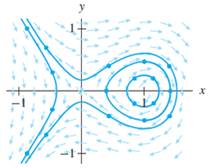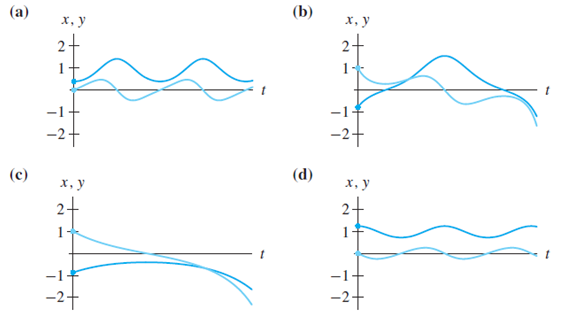
Differential Equations (with DE Tools Printed Access Card)
4th Edition
ISBN: 9781133109037
Author: Paul Blanchard
Publisher: Cengage Learning
expand_more
expand_more
format_list_bulleted
Concept explainers
Textbook Question
Chapter 2.2, Problem 21E
Consider the four solution curves in the phase portrait and the four pairs of x(t)- and y(t)-graphs shown below. 
Match each solution curve with its corresponding pair of x(t)- and y(t)-graphs. Then on the x-axis mark the t-values that correspond o the distinguished points along the curve. 
Expert Solution & Answer
Want to see the full answer?
Check out a sample textbook solution
Students have asked these similar questions
Q/By using Hart man theorem study the Stability of the
critical points and draw the phase portrait
of the system:-
X = -4x+2xy - 8
y° = 4y²
X2
This means that when the Radius of Convergence of the Power Series is a "finite positive real number" r>0, then every point x of the Power Series on (-r, r) will absolutely converge (x ∈ (-r, r)). Moreover, every point x on the Power Series (-∞, -r)U(r, +∞) will diverge (|x| >r). Please explain it.
Explain the conditions under which Radious of Convergence of Power Series is infinite. Explain what will happen?
Chapter 2 Solutions
Differential Equations (with DE Tools Printed Access Card)
Ch. 2.1 - Exercises 1-6 refer to the following systems of...Ch. 2.1 - Exercises 1-6 refer to the following systems of...Ch. 2.1 - Exercises 1-6 refer to the following systems of...Ch. 2.1 - Exercises 1-6 refer to the following systems of...Ch. 2.1 - Prob. 5ECh. 2.1 - Prob. 6ECh. 2.1 - Consider the predator-prey system...Ch. 2.1 - Consider the predator-prey system dRdt=2R(1R...Ch. 2.1 - Exercises 9-14 refer to the predator-prey and the...Ch. 2.1 - Exercises 9-14 refer to the predator-prey and the...
Ch. 2.1 - Exercises 9-14 refer to the predator-prey and the...Ch. 2.1 - Prob. 12ECh. 2.1 - Prob. 13ECh. 2.1 - Exercises 9-14 refer to the predator-prey and the...Ch. 2.1 - Prob. 15ECh. 2.1 - Consider the system of predator-prey equations...Ch. 2.1 - Pesticides that kill all insect species are not...Ch. 2.1 - Some predator species seldom capture healthy adult...Ch. 2.1 - Prob. 19ECh. 2.1 - Consider the initial-value problem d2ydt2+kmy=0...Ch. 2.1 - A mass weighing 12 pounds stretches a spring 3...Ch. 2.1 - A mass weighing 4 pounds stretches a spring 4...Ch. 2.1 - Do the springs in an “extra firm’ mattress have a...Ch. 2.1 - Consider a vertical mass-spring system as shown in...Ch. 2.1 - Exercises 25—30 refer to a situation in which...Ch. 2.1 - Prob. 26ECh. 2.1 - Prob. 27ECh. 2.1 - Prob. 28ECh. 2.1 - Prob. 29ECh. 2.1 - Exercises 25—30 refer to a situation in which...Ch. 2.2 - Prob. 1ECh. 2.2 - Prob. 2ECh. 2.2 - Prob. 3ECh. 2.2 - Prob. 4ECh. 2.2 - Prob. 5ECh. 2.2 - Prob. 6ECh. 2.2 - Prob. 7ECh. 2.2 - Convert the second-order differential equation 1...Ch. 2.2 - Prob. 9ECh. 2.2 - Consider the system dxdt=2x+ydydt=2y and its...Ch. 2.2 - Eight systems of differential equations and four...Ch. 2.2 - Consider the modified predator-prey system...Ch. 2.2 - In Exercises 13—18. (a) find the equilibrium...Ch. 2.2 - Prob. 14ECh. 2.2 - Prob. 15ECh. 2.2 - In Exercises 13—18. (a) find the equilibrium...Ch. 2.2 - Prob. 17ECh. 2.2 - In Exercises 13—18. (a) find the equilibrium...Ch. 2.2 - Prob. 19ECh. 2.2 - Prob. 20ECh. 2.2 - Consider the four solution curves in the phase...Ch. 2.2 - Prob. 22ECh. 2.2 - Prob. 23ECh. 2.2 - Prob. 24ECh. 2.2 - Prob. 25ECh. 2.2 - Prob. 26ECh. 2.2 - Prob. 27ECh. 2.3 - In Exercises 1—4, a harmonic oscillator equation...Ch. 2.3 - In Exercises 1—4, a harmonic oscillator equation...Ch. 2.3 - In Exercises 1—4, a harmonic oscillator equation...Ch. 2.3 - In Exercises 1—4, a harmonic oscillator equation...Ch. 2.3 - Prob. 5ECh. 2.3 - In the damped harmonic oscillator, we assume that...Ch. 2.3 - Consider any damped harmonic oscillator equation...Ch. 2.3 - Consider any damped harmonic oscillator equation...Ch. 2.3 - In Exercises 9 and 10, we consider a mass sliding...Ch. 2.3 - In Exercises 9 and 10, we consider a mass sliding...Ch. 2.4 - In Exercises 1-4, we consider the system...Ch. 2.4 - In Exercises 1-4, we consider the system...Ch. 2.4 - In Exercises 1-4, we consider the system...Ch. 2.4 - In Exercises 1-4, we consider the system...Ch. 2.4 - In Exercises 5-12, we consider the partially...Ch. 2.4 - Prob. 6ECh. 2.4 - In Exercises 5-12, we consider the partially...Ch. 2.4 - Prob. 8ECh. 2.4 - In Exercises 5-12, we consider the partially...Ch. 2.4 - In Exercises 5-12, we consider the partially...Ch. 2.4 - Prob. 11ECh. 2.4 - Prob. 12ECh. 2.4 - Consider the partially decoupled system...Ch. 2.5 - Prob. 1ECh. 2.5 - Prob. 2ECh. 2.5 - Prob. 3ECh. 2.5 - In Exercises 3—6, a system, an initial condition,...Ch. 2.5 - Prob. 5ECh. 2.5 - Prob. 6ECh. 2.5 - Using a computer or calculator, apply Euler’s...Ch. 2.5 - Prob. 8ECh. 2.6 - Consider the system dxdt=x+ydydt=y (a) Show that...Ch. 2.6 - Prob. 2ECh. 2.6 - Prob. 3ECh. 2.6 - Prob. 4ECh. 2.6 - Prob. 5ECh. 2.6 - Prob. 6ECh. 2.6 - Prob. 7ECh. 2.6 - (a) Suppose Y1(t) is a solution of an autonomous...Ch. 2.6 - Prob. 9ECh. 2.6 - Consider the system dxdt=2dydt=y2 (a) Calculate...Ch. 2.6 - Consider the system dxdt=2dydt=y2 Show that, for...Ch. 2.7 - Prob. 1ECh. 2.7 - In the SIR model, we assume that everyone in the...Ch. 2.7 - Vaccines make it possible to prevent epidemics....Ch. 2.7 - Prob. 4ECh. 2.7 - Prob. 5ECh. 2.7 - One of the basic assumptions of the SIR model is...Ch. 2.7 - Prob. 7ECh. 2.7 - Prob. 8ECh. 2.7 - Prob. 9ECh. 2.7 - Using =1.66 and the value of that you determined...Ch. 2.8 - Prob. 1ECh. 2.8 - Prob. 2ECh. 2.8 - Prob. 3ECh. 2.8 - Prob. 4ECh. 2.8 - Prob. 5ECh. 2 - Prob. 1RECh. 2 - Short answer exercises: Exercises 1-14 focus on...Ch. 2 - Short answer exercises: Exercises 1-14 focus on...Ch. 2 - Short answer exercises: Exercises 1-14 focus on...Ch. 2 - Short answer exercises: Exercises 1-14 focus on...Ch. 2 - Short answer exercises: Exercises 1-14 focus on...Ch. 2 - Prob. 7RECh. 2 - Prob. 8RECh. 2 - Prob. 9RECh. 2 - Prob. 10RECh. 2 - Prob. 11RECh. 2 - Prob. 12RECh. 2 - Short answer exercises: Exercises 1-14 focus on...Ch. 2 - Prob. 14RECh. 2 - Prob. 15RECh. 2 - Prob. 16RECh. 2 - Prob. 17RECh. 2 - Prob. 18RECh. 2 - Prob. 19RECh. 2 - Prob. 20RECh. 2 - Prob. 21RECh. 2 - Prob. 22RECh. 2 - Prob. 23RECh. 2 - Prob. 24RECh. 2 - Prob. 25RECh. 2 - Prob. 26RECh. 2 - Prob. 27RECh. 2 - Prob. 28RECh. 2 - Prob. 29RECh. 2 - Prob. 30RECh. 2 - In Exercises 31-34, a solution curve in the...Ch. 2 - Prob. 32RECh. 2 - Prob. 33RECh. 2 - Prob. 34RECh. 2 - Consider the partially decoupled system...Ch. 2 - Consider the partially decoupled system...Ch. 2 - Prob. 37RE
Knowledge Booster
Learn more about
Need a deep-dive on the concept behind this application? Look no further. Learn more about this topic, subject and related others by exploring similar questions and additional content below.Similar questions
- Explain the conditions under Radius of Convergence which of Power Series is 0arrow_forwardExplain the key points and reasons for 12.8.2 (1) and 12.8.2 (2)arrow_forwardQ1: A slider in a machine moves along a fixed straight rod. Its distance x cm along the rod is given below for various values of the time. Find the velocity and acceleration of the slider when t = 0.3 seconds. t(seconds) x(cm) 0 0.1 0.2 0.3 0.4 0.5 0.6 30.13 31.62 32.87 33.64 33.95 33.81 33.24 Q2: Using the Runge-Kutta method of fourth order, solve for y atr = 1.2, From dy_2xy +et = dx x²+xc* Take h=0.2. given x = 1, y = 0 Q3:Approximate the solution of the following equation using finite difference method. ly -(1-y= y = x), y(1) = 2 and y(3) = −1 On the interval (1≤x≤3).(taking h=0.5).arrow_forward
- Q3)A: Given H(x,y)=x2-x+ y²as a first integral of an ODEs, find this ODES corresponding to H(x,y) and show the phase portrait by using Hartman theorem and by drawing graph of H(x,y)-e. Discuss the stability of critical points of the corresponding ODEs.arrow_forwardQ/ Write Example is First integral but not Conservation system.arrow_forwardQ/ solve the system X° = -4X +2XY-8 y°= 2 4y² - x2arrow_forward
- Answer the questionsarrow_forwardWhich angles are complementary to each other? Select all that apply. 3 2 4 in 5 1 Z1 and 23 Z1 and 25 22 and 23 Z2 and 25 Submitarrow_forwardWhich angles are adjacent to each other? Select all that apply. 3 2 4 67 5 8 11 10 12 12 9 27 and 28 Z9 and 12 Z3 and 24 Z10 and Z11arrow_forward
arrow_back_ios
SEE MORE QUESTIONS
arrow_forward_ios
Recommended textbooks for you
- Algebra & Trigonometry with Analytic GeometryAlgebraISBN:9781133382119Author:SwokowskiPublisher:Cengage

Algebra & Trigonometry with Analytic Geometry
Algebra
ISBN:9781133382119
Author:Swokowski
Publisher:Cengage
01 - What Is A Differential Equation in Calculus? Learn to Solve Ordinary Differential Equations.; Author: Math and Science;https://www.youtube.com/watch?v=K80YEHQpx9g;License: Standard YouTube License, CC-BY
Higher Order Differential Equation with constant coefficient (GATE) (Part 1) l GATE 2018; Author: GATE Lectures by Dishank;https://www.youtube.com/watch?v=ODxP7BbqAjA;License: Standard YouTube License, CC-BY
Solution of Differential Equations and Initial Value Problems; Author: Jefril Amboy;https://www.youtube.com/watch?v=Q68sk7XS-dc;License: Standard YouTube License, CC-BY